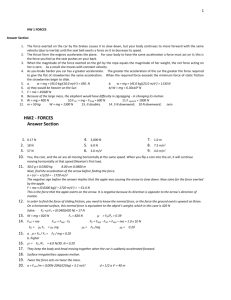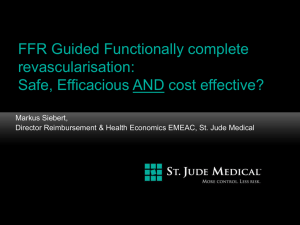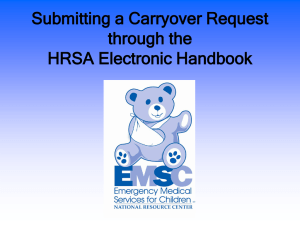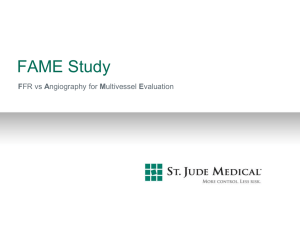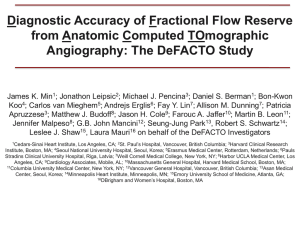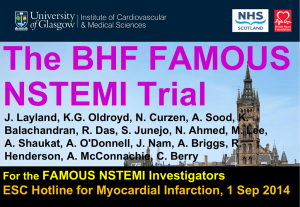Supplementary Data File - European Heart Journal
advertisement
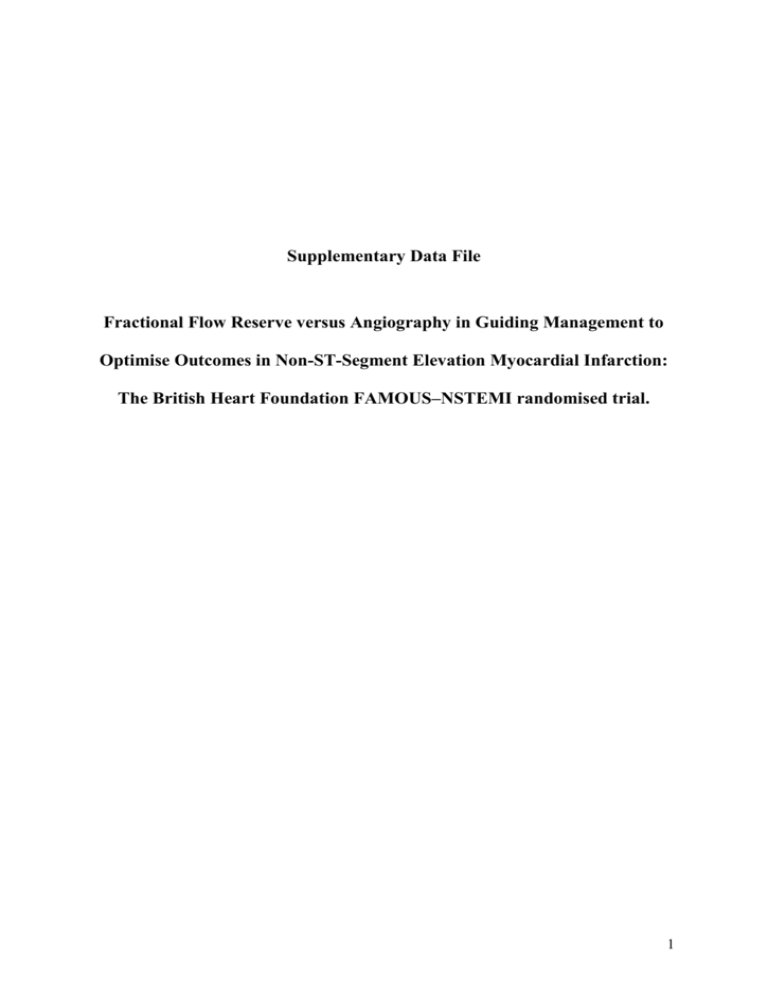
Supplementary Data File Fractional Flow Reserve versus Angiography in Guiding Management to Optimise Outcomes in Non-ST-Segment Elevation Myocardial Infarction: The British Heart Foundation FAMOUS–NSTEMI randomised trial. 1 FFR-guided vs. Angiography-guided treatment groups Relationships between lesion classification by angiography alone vs. angiography with FFR FFR was measured in at least one artery in all (100%) patients. 706 lesions (n=354 in the FFR-guided group and n=351 in the angiography-guided group) had a diameter stenosis severity ≥ 30% based on visual interpretation of the coronary angiogram and FFR was measured in 704 (99.7%) of these lesions. Two patients with multivessel disease lacked an FFR measurement in a diseased side branch. Based on visual assessment of the coronary angiogram, 645 lesions (91.4%) had a diameter stenosis severity ≥ 50% and 496 (70.3%) had a diameter stenosis severity ≥ 70%. Of 704 lesions with an FFR result, 430 (61.1%) were functionally significant (FFR ≤ 0.80) (Table 2). Ten patients (2.9%) had no lesions (stenosis severity < 50%) when assessed by angiography and 63 (18·0%) patients had no lesions when subsequently assessed by FFR (> 0.80). The proportions of patients classified with 0, 1, 2, or 3 vessel disease in each group is shown in Figure 1. 2 Relationship between FFR and time to the index procedure. Table 1. Time from index event to procedure FFR >3 days ≤3 days n; mean FFR (SD) n; mean FFR (SD) p Segments 336; 0.71 (0.18) 368; 0.68 (0.18) 0.063 Vessel Groups 326; 0.70 (0.18) 358; 0.68 (0.18) 0.095 Arteries 306; 0.70 (0.19) 338; 0.67 (0.18) 0.065 Patients 166; 0.62 (0.18) 184; 0.57 (0.15) 0.008 These results show that FFR tend to be lower in patients assessed ≤3 days from the index event to the procedure compared to in patients assessed > 3 days. 3 Serious adverse cardiovascular events in patients treated with medical therapy only Sixty three (18·0%) patients were treated with medical therapy, of whom 40 (22.7%) were randomly assigned to the FFR-guided group and 23 (13.2%) were randomised to the angiography-guided group. During 12 months follow-up 3/40 (7.5%) in the FFR-guided group had a MACE event during 12 months followup vs. 0/23 (0%) in the angiography-guided group (difference 7.5% (confidence interval -7.4%, 20.7%); p=0.22). Table 2. Adverse events in the medically-managed participants. All of these events occurred in participants randomised to the FFR-guided group. Participant (age, sex) 60, male Invasive findings for culprit lesion (location, angiographic stenosis severity) Invasive findings for non-culprit lesion (location, angiographic stenosis severity) Initial treatment plan based on the angiogram FFR result and treatment plan after FFR disclosure Adverse cardiovascular event and treatment* Intermediate artery, 70% focal stenosis, FFR = 0.86 No lesions PCI Medical therapy NSTEMI 7 weeks after randomisation PCI performed to culprit intermediate artery stenosis despite FFR > 0.80. 49, male 46, male Proximal circumflex, 70% stenosis Right coronary artery, 100% stenosis Mid left anterior descending artery, 60% stenosis Mid left anterior descending artery, 60% stenosis PCI CABG Circumflex artery FFR = 0.94, NSTEMI 8 months after randomisation Left anterior descending artery FFR = 0.83; Medical therapy Medical management. FFR = 0.87 Severe left ventricular dysfunction at baseline (LV ejection fraction < 30%) but no implantable Medical therapy 4 defibrillator; sudden cardiac death 63, male Proximal left anterior descending coronary artery, 75% focal stenosis. No lesions PCI to culprit lesion FFR = 0.86 Medical therapy Coronary guidewire related dissection during the index procedure; FFR-guided decision for medical therapy changed to PCI in order to treat the dissection. PCI was performed but MI did not occur. *Adverse cardiovascular events were assessed and adjudicated by a clinical event committee. The committee included 3 cardiologists who were independent of the study and blind to treatment group assignment. De-identified source clinical data were provided to the committee members. 5 Revascularisation within 12 months Compared with the angiography-guided group, the percentage of patients who were free from coronary revascularisation remained higher in the FFR disclosure group at 12 months (37 (21.0%) vs. 23 (13.2%), difference 7.8% (-0.2%, 15.8%), p=0.054; relative risk 1.59 (0.99, 2.62)). The results for revascularisation from randomisation at baseline to 12 months according to procedure type (PCI or CABG) are shown in Table 3. Table 3. Revascularisation by PCI or CABG at 12 months FFR Angio Risk Diff p-value PCI 128 (72.7%) 139 (79.9%) -7.2% (-16.2%, 1.8%) p=0.12 CABG 11 (6.2) 12 (6.9%) -0.7% (-6.2%, 4.8%) p=0.87 6 Supplementary Figure Legends Figure 1. The proportions of patients with 0, 1, 2, or 3 vessel disease in the angiography-guided and FFR-guided groups. The number of patients with 1, 2, or ≥ 3 vessel coronary disease was 130 (37.1%), 141 (40.3%) and 69 (19.8%) when assessed by angiography (stenosis severity ≥ 50%), and 181 (51.7%), 81 (23.1%), and 25 (7.2%) patients when assessed by FFR (≤ 0.80). Figure 2. Relationship between angiographic stenosis severity assessed visually before randomisation and FFR for culprit lesions (A) and non-culprit lesions (B). Culprit lesion status was determined by the cardiologist based on all of the clinical data including the angiogram, before FFR was measured. Figure 3. Kaplan-Meier plots for major adverse cardiac events (MACE) during 12 months follow-up in the FFR-guided group and angiography-guided group. MI events associated with revascularisation (Types IV and V MI) are excluded so the MACE outcome includes spontaneous MI events post-randomisation only. 7 Figure 1. 8 Figure 2. (a) Culprit lesions: FFR vs. stenosis severity (b) Non-culprit lesions: FFR vs. stenosis severity. 9 Figure 3. 10
